|
Special Features





Image Libraries


|
|
Blog
By prioritizing elevator information rather than train arrivals on its platform displays, WMATA forces riders to make bad decisions. The result: inefficient use of sparse train capacity.
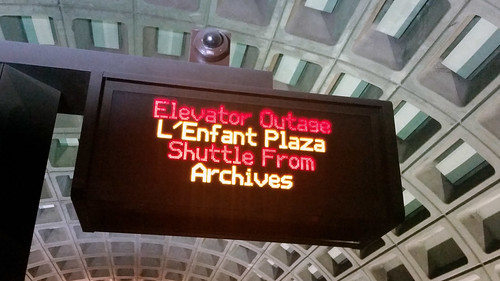
Not the best use of this technology.
Picture yourself in this scenario
Imagine you’re descending into a Red Line station. You hear a train approaching and rush to the platform. The train pulls up and you see that it’s full.
You glance over at the real-time train arrival display, hoping there will be another train a minute or two behind. If so, you’ll wait for it rather than crowd on now. Maybe you’ll have just enough time to move down the platform to a less crowded spot.
Alas, the display is cycling through elevator outages on the Orange Line in Virginia. Who knows how long until the next train arrives. You’d better crowd on now.
Prioritizing less important info results in badly informed riders
Scenarios like that play out thousands of times every day all over the Metrorail system. It happens because Metro’s PIDs, the Passenger Information Displays that show how long until the next train arrives, are programmed to also cycle through each elevator outage in the entire system.
Cycling through elevator outages often takes a long time, making it difficult for riders to get the real-time train arrival information that the displays were invented to show.
In turn, badly-informed riders can’t use the system efficiently, and exacerbate overcrowding. Without good information, riders push onto full trains when an empty one is a minute behind, and rush into the nearest door rather than move down the platform to a less crowded one.
Those are increasingly important problems given Metro’s capacity limitations.
Wheelchair users need elevator info
WMATA displays elevator outages on the PIDs because it’s crucial information for a small minority of riders: the wheelchair bound, and others who can’t use escalators or stairs.
For those groups, having plenty of advanced notice about which elevators are out is absolutely necessary. Removing that information from stations would therefore be an unacceptable trade-off.
But that information doesn’t have to be on the same screens as train arrival information. In fact, trying to display multiple elevator outages on the PIDs, where there’s only enough room to scroll through them one by one, is a remarkably bad way to provide that information.

A better way, in Chicago. Photo by Matt’ Johnson on Flickr.
Displaying elevator outages on the PIDs requires riders who need that information to wait and watch an entire cycle, even if a train they could take is on the platform now.
It would be far more efficient to display that info on a separate screen that can show several outages at once, like the larger more advanced screens at station manager kiosks.
Or even a low-tech dry erase board, the preferred solution for Chicago’s CTA.
By trying to satisfy two entirely different sets of needs with one limited screen that runs on decades-old technology, WMATA isn’t getting as much out of the PIDs as it could.
 Comment on this at the version cross-posted to Greater Greater Washington. Comment on this at the version cross-posted to Greater Greater Washington.
Average Rating: 4.8 out of 5 based on 185 user reviews.
July 24th, 2015 | Permalink
Tags: metrorail, transportation

Earlier this year, outside experts identified 33 issues for DDOT to address before the H Street streetcar can open. According to DDOT spokespeople, 12 of those 33 have since been completely fixed. The remaining 21 are in progress.
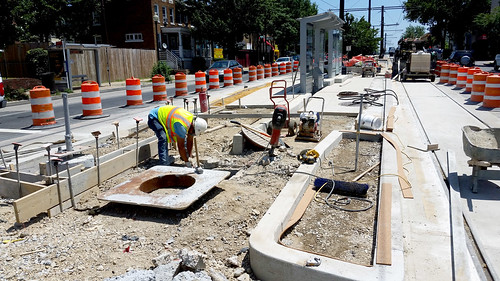
Workers modify 19th Street station following an APTA review of the DC Streetcar.
According to new DC Streetcar Launch Manager Timothy Borchers, workers are making significant progress towards satisfying the 33 recommendations from this spring’s APTA review.
Borchers himself is one of the solutions. DDOT hired him this spring, following an APTA recommendation that DDOT bring on more experienced project managers. Borchers worked for years on the world’s largest streetcar network in Melbourne, Australia, and helped launch the new Atlanta Streetcar in 2014.
Progress report
During an interview with reporters last week, Borchers didn’t supply a specific list of exactly which 12 of the 33 total items are complete. But he did outline DDOT’s recent progress.
Among the items that are complete: Crews have repaired the three cracked tracks, several new staff people have been hired (including Borchers himself), DDOT has finalized its pre-revenue operations plan, and crews now track all streetcar work using a single master matrix.
As for the rest, all 21 remaining items “are in some stage of completion, ” says Borchers.
Platform modifications
The most visible work in progress now is retrofitting the 19th Street station to meet disability accessibility standards. The slope of the concrete in the original platform was a few degrees off from federal requirements. Therefore, crews are now re-leveling the platform.
Workers may soon begin modifying other platforms, to prevent streetcar doors from scraping against the platform edge. Although Borchers was careful to note that DDOT is still in the process of determining its exact solution to the scraping problem, he says it’s being caused by the streetcars’ self-leveling system, hydraulics that keep streetcars level with the platforms at stations.
Workers may only need to fine-tune the streetcars’s self-leveling system, but it may also be necessary to adjust some of the platforms.
Meanwhile, engineers are working on a new design for a set of stairs near the streetcar railyard, where the narrow landing between the bottom of the stairs and the edge of the streetcar tracks is potentially dangerous. The new design will add a “pivot, ” so the stairs empty onto a landing parallel to the tracks rather than leading directly into them.

Existing stairs leading straight to the streetcar tracks. Photo from DDOT.
Streetcar vehicle fixes
Inside the car barn, changes are underway to the streetcar vehicles themselves.
After one of DC’s streetcars caught fire in February, analysis determined the cause was inadequate insulation on the pantograph—the electrical mechanism connecting the streetcars to the overhead power wires.
Although it was a DC streetcar that caught fire, the problem was with the railcar’s design. Thanks to lessons learned from the DC fire, all streetcars nationwide manufactured by United Streetcar are now being retrofitted with improved insulation.
If you spot a United Streetcar on Benning Road, its retrofit is complete and its pantograph is safe.
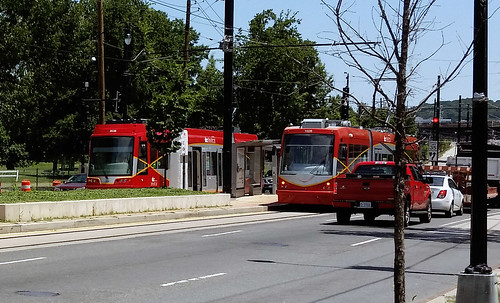
A retrofitted United Streetcar (left), with a Czech-built streetcar (right) on Benning Road, on Thursday, July 16.
Another change coming to the railcars is rear-view cameras. The APTA review recommended replacing rear-view mirrors with cameras in order to narrow the profile of the railcars, to help avoid side collisions with parked cars.
As of Thursday, the cameras have been installed but the mirrors have not yet been removed.
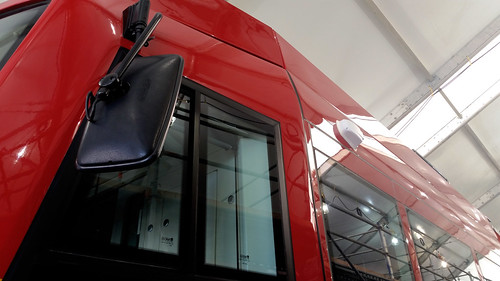
The white attachment at upper right is the new rear-view camera.
No fences for Benning Road
One APTA recommendation that DDOT has decided to only partially implement is the suggestion to add fences to H Street and Benning Road, in order to cut down on jaywalking.
Borchers explained that while fencing can be appropriate for rail lines in other types of environments, it’s inherently incompatible with a busy main street where there are lots of pedestrians. DDOT will install a short segment of fencing on the Hopscotch Bridge, but otherwise H Street and Benning Road will remain fence-free.
Instead, more signs and pavement markings will warn pedestrians to watch out for streetcars.
Next steps
According to Borchers, DDOT workers will continue to power through the remaining 21 items this summer, working towards final certification from DC’s safety oversight office.
When everything is finally ready to go, the streetcar will enter a final pre-revenue operations phase, simulating the exact operations of passenger service.
Since DDOT already performed significant pre-revenue operations in the waning days of the Gray administration, they’ll be able to follow a reduced timeline on this second go around. Once it begins, that will likely take two to three weeks, if everything goes well.
 Comment on this at the version cross-posted to Greater Greater Washington. Comment on this at the version cross-posted to Greater Greater Washington.
Average Rating: 5 out of 5 based on 226 user reviews.
July 21st, 2015 | Permalink
Tags: streetcar, transportation

As designs for the Corridor Cities Transitway BRT line solidify, officials are revising plans to try and cut costs and ease approvals. Among the changes: Smaller stations, fewer dedicated lanes, and fewer grade-separated street crossings.
 |
 |
| >Original two-bus station design (left) and smaller one-bus design (right). All images from Maryland. |
Smaller stations
According to initial designs, all transitway stations would have been 150 feet long, large enough to comfortably accommodate two articulated buses in each direction.
The revised plans reduce six of the transitway’s ten stations down to 65 feet long, and the other four stations down to 125 feet.
The 125-foot stations will still be able to squeeze in two buses at a time. The 65-foot stations will only fit a single bus. All stations will be designed so they can expand to 125 feet later if necessary.
With buses scheduled to come every six minutes at peak times, single-bus stations could cause delays if buses begin to bunch together.
Dedicated lanes at the Belward property
The Corridor Cities Transitway will be, for the most part, true BRT. It will have a dedicated running way for most of its length. But now officials are proposing that it run in mixed traffic for a 1.1 mile detour around the Belward property, aka the last farm in Gaithersburg.

Original alignment through the Belward property (left) and proposed mixed-traffic realignment around it (right).
This change isn’t to save money, nor is it to avoid upsetting car drivers. It has to do with the historic farmhouse in the middle of the property.
Under federal rules concerning historic preservation, the state cannot build the transitway through the farm unless the property is disturbed by development first. But Montgomery County’s master plan does not allow for development on the farm until after the transitway is up and running. It’s a chicken and egg problem.
Thus Maryland’s new plan: Buses will detour around Belward farm on existing roads, in mixed traffic.
It’s not clear whether the detour plan is supposed to be temporary or permanent. It could be the state will operate the detour at first, long enough to allow development at Belward, and then retrofit in the dedicated transitway once development is underway.
Or it could be the state will never correct this problem, and buses will run in mixed-traffic around Belward long after buildings have replaced the farm. Time will tell.
At-grade street crossing
Another major cost-saving change is coming where the transitway crosses MD Route 28, Key West Avenue.

Transitway crossing of Key West Avenue.
Initial plans called for an underpass below Key West Avenue. Buses never would have had to stop for a red light. New plans show a surface crossing, meaning buses will have to contend with traffic signals.
And although the state webpage does clearly say that an at-grade crossing will have minimal “effects on general traffic flow through the intersection, ” it doesn’t say anything about how this change will affect transit travel time.
Questions about cost
Montgomery County official Glenn Orlin recently revealed that costs for the transitway are climbing.
The most recent state cost estimate, from 2012, was for $545 million. Officially that’s still the estimate. But Orlin says a new estimate is forthcoming and will be “in the $700-800 million range.” If true, that’s a troubling increase, and could explain some of the state’s moves to reduce costs.
On the other hand, Orlin also indicated the new estimate is in year-of-construction dollars, while the old estimate was in 2012 dollars. If so, inflation could account for the lion’s share of the difference. Until the actual estimate comes out, it’s impossible to know.
It may not matter anyway, as the transitway remains unfunded, and prospects for funding under Maryland Governor Hogan appear slim.
 Comment on this at the version cross-posted to Greater Greater Washington. Comment on this at the version cross-posted to Greater Greater Washington.
Average Rating: 4.6 out of 5 based on 204 user reviews.
July 14th, 2015 | Permalink
Tags: BRT, master planning, transportation

The long-delayed H Street Streetcar has been shrouded in secrecy for months. But now DDOT has released a report detailing the exact causes of the delays, and what they must do to fix them.

Red stripes next to streetcar tracks indicate where it’s unsafe to pass stopped cars. They’re installed wherever the tracks cross traffic lanes. Photo by Sean Emerson.
The complete list of 33 fixes is detailed below.
The list comes via an independent report from the American Public Transportation Association (APTA). The recommendations are a mix of back-end organizational issues and physical problems with the line’s construction.
The final report confirms the APTA’s preliminary finding from this spring, that none of the problems are fatal flaws. All 33 items on the list are fixable.
DDOT has been working on fixes for months
DDOT has yet to comment on the status of fixes, but it’s clear the agency has been working on them.
For example, one item on the list notes that streetcar doors scrape against some station platforms when they open. Last month, DDOT began modifying platforms to correct this problem.
Another example is the thick lines of red paint that DDOT added at key locations along H Street this spring. The paint is a visual warning for when the streetcar tracks swerve across travel lanes (like when they shift from the left lane to the right lane at Benning Road and Maryland Ave). If a car is inside the painted area at the track crossing, the streetcar doesn’t have room to pass safely.
The complete list
The full 33-item list comes in two parts: The first 18 items are from the preliminary findings that came out in March. Following that, there are 15 new items.
Here they all are:
18-item preliminary list
- In conducting safety certification, the DC State Safety Oversight office should allow flexibility in resolving problem issues. Workarounds that adequately resolve safety issues may be considered acceptable as temporary fixes, provided DDOT identify a plan for permanent solutions.
- Hire a qualified chief safety officer.
- Hire additional technical staff with more experience in light rail / streetcar construction and operating.
- Repair breaks in the streetcar rails at three locations.
- Ensure the six railcars are all in a state of good repair, including railcar #202 which caught fire in February, 2015.
- Investigate why streetcar doors scrape at stations, and fix the problem.
- Add more prominent pavement graphics indicating where streetcars stop at stations, and add pavement graphics at switch points and passing locations to indicate to streetcar operators when it’s safe to pass another streetcar.
- Ensure all on-board radios are working.
- Add additional lighting at streetcar stations.
- Complete a new safety assessment.
- Hire an independent expert to ensure compliance with the Americans with Disabilities Act (ADA). Specifically, have this expert review and if necessary correct the design of the rumble strips at station platforms.
- Train maintenance staff more thoroughly, so they’ll catch problems such as rail cracks sooner.
- Develop a pre-revenue operations plan, and do additional streetcar testing after all right-of-way and vehicle issues are resolved.
- Add heaters to rail switches, so they can melt snow pack.
- Resolve items from the previous safety & security reports.
- Develop a centralized tracking system for managing and resolving problems. DDOT’s current system is decentralized and results in oversights.
- Review documents describing operating & maintenance procedures, and correct inconsistencies and incomplete sections.
- Develop an opening day operating schedule.
15-item followup list
Items 19-26 all deal with recommendations for back-end reorganization of DDOT’s streetcar office. Most notably, APTA recommends DDOT appoint a single dedicated project manager with authority to make decisions, and delegate additional specific decision-making authorities to other designated staff. Currently all decisions are being elevated to the DDOT director, causing delays and leading to a lack of clarity regarding who is responsible for fixing problems.
- Conduct team building exercises to help streetcar staff work together better.
- Replace streetcar side mirrors with rear-facing cameras, reducing the width of the streetcars and thus reducing the risk of scraping parked cars.
- Ensure pedestrians on the south side of the Hopscotch Bridge have a safe and clearly-marked path. At the time of the APTA review, construction of Station House DC was blocking the sidewalk and stranding pedestrians.
- Add additional protection for pedestrians at the foot of the stairway at the Benning Road entrance to the streetcar carbarn, where a stairway terminates directly into the streetcar tracks.

Photo from DDOT.
- Install a fence or landscaping along the street to prevent jaywalking.
- Add larger signs and additional on-street stencils warning car drivers to park inside the white line.
- Add bigger streetcar speed and signal signs. Current signs are too small for streetcar operators to see.
 Comment on this at the version cross-posted to Greater Greater Washington. Comment on this at the version cross-posted to Greater Greater Washington.
Average Rating: 5 out of 5 based on 273 user reviews.
July 9th, 2015 | Permalink
Tags: streetcar, transportation

When Maryland governor Larry Hogan canceled Baltimore’s Red Line and cut state funding from the Purple Line, he shifted over a billion dollars from transit to road construction. Here are the road projects he plans to build with that money.
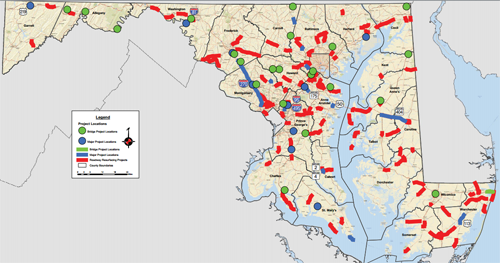
Image from Maryland.
On the map, blue lines and dots illustrate major highway projects. Red lines are smaller road projects, and green dots are bridge projects.
There are three major highway projects in the Washington region, on I-270, the Beltway, and Route 1. Most of the money is going to projects in other parts of the state.
I-270 in Montgomery
Montgomery County will get one big project: $100 million for “innovative congestion reduction” on I-270, between the Beltway and I-370.

Image from Maryland.
That won’t be a widening. It will be operational tweaks to squeeze more efficiency out of the pavement that’s already there. MDOT will introduce things like ramp meters, bus-on-shoulder, and signals that let motorists drive on the shoulder at peak times.
Officials haven’t determined the exact location or mix of projects yet, but all three of those strategies have helped Virginia squeeze more capacity out of I-66.
Two in Prince George’s
Prince George’s will get two big projects: $185 million to expand the Beltway interchange at Greenbelt Metro station, and $30 million to rebuild US-1 through downtown College Park.
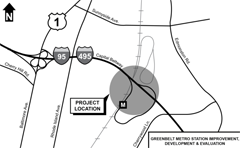 |
 |
Greenbelt interchange (left) and US-1 in College Park (right).
Images from Maryland. |
The Greenbelt project will add new highway ramps, so drivers coming from northbound I-495 will be able to get to the Metro station, and so drivers leaving Metro will be able to reach southbound I-495. Those movements aren’t possible today.
The College Park project will make US-1 a four-lane highway with a raised median, and add better bicycle and pedestrian accommodations. This is the same project GGW has advocated for over the past year, although it’s not clear from Hogan’s announcement what the final design will look like.
Most of the money goes elsewhere
Those three projects will most directly affect Washington-area drivers. Here are the biggest new projects elsewhere in the state:
July 7th, 2015 | Permalink
Tags: Uncategorized

Do you know of a safety problem on a DC street? If so, tell DDOT about it using the interactive Vision Zero map. It allows residents to click a location and type in notes to describe problems.

Image from DDOT.
This new map is part of DC’s Vision Zero Initiative, which aims to eliminate all fatalities and serious injuries in the transportation system.
The map lets you add notations for a wide variety of safety problems. There are separate categories for driver, pedestrian, and cyclist problems, with several options available for each. You can also scroll around DC to see what your neighbors have submitted.
It’s a neat tool. I’ve already submitted a handful of problems.
 Comment on this at the version cross-posted to Greater Greater Washington. Comment on this at the version cross-posted to Greater Greater Washington.
Average Rating: 4.9 out of 5 based on 224 user reviews.
July 1st, 2015 | Permalink
Tags: bike, pedestrians, roads/cars, transportation

|
Media





Site
About BeyondDC
Archive 2003-06
Contact
Category Tags:
Partners
|


 Comment on this at the version cross-posted to Greater Greater Washington.
Comment on this at the version cross-posted to Greater Greater Washington.



























